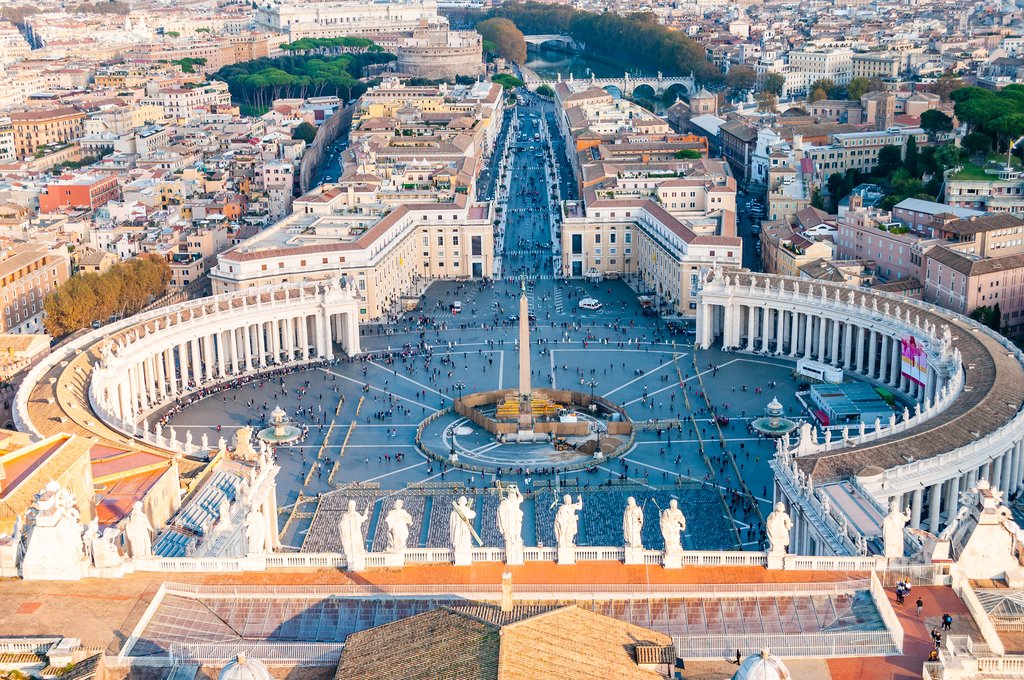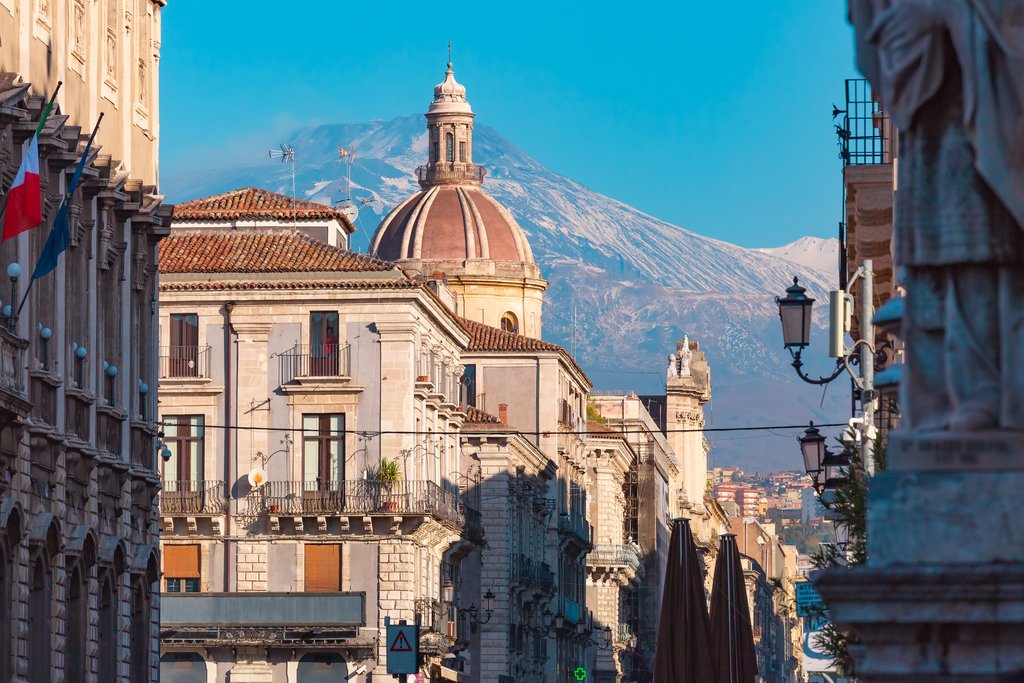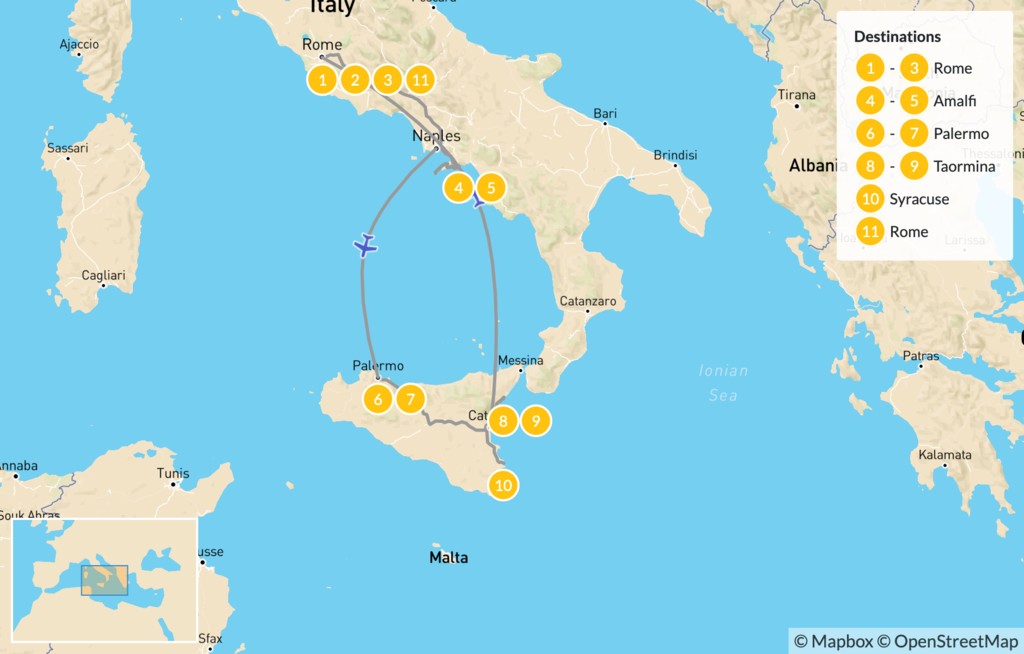Highlights
- Tour the halls and basilicas of the Vatican with a guide
- Enjoy a day trip from the Amalfi Coast to the island of Capri
- See the historic plazas and Baroque fountains of Palermo
- Visit some of the most important ancient Greek ruins in Sicily
Brief Itinerary
| Day | Highlights | Overnight |
|---|---|---|
| Day 1 | Arrival in Rome | Rome |
| Day 2 | Vatican & Classic Tour of Rome | Rome |
| Day 3 | Private Colosseum & Forum Tour - Cooking Class | Rome |
| Day 4 | Transfer to the Amalfi Coast | Amalfi |
| Day 5 | Capri and Anacapri Day Tour | Amalfi |
| Day 6 | Fly From Naples to Palermo - Pick up Rental Car | Palermo |
| Day 7 | Guided Tour of Palermo - Visit Monreale | Palermo |
| Day 8 | Drive From Palermo to Taormina - Visit Cefalù | Taormina |
| Day 9 | Explore Taormina - Guided Mount Etna Hike | Taormina |
| Day 10 | Drive from Taormina to Syracuse - Visit Noto | Syracuse |
| Day 11 | Drive from Syracuse to Catania - Fly to Rome | Rome |
| Day 12 | Goodbye, Italy |
Detailed Itinerary
Day 1: Arrival in Rome

Welcome to Rome, City of the Seven Hills! According to legend, Rome was founded by brothers Romulus and Remus in 753 BCE atop Palatine Hill. The long-time center of the powerful Roman Empire, Rome boasts nearly 3,000 years of architecture, history, and culture.
After arriving at one of Rome's airports, you'll transfer to your hotel in the historic center. Settle in and relax, then head out for a stroll and your first look at the Eternal City. Your next few days will involve lots of sightseeing, so check out some of Rome's landmarks and sites.
For an authentic market experience stop by the Mercato dei Fiori, where locals shop for fresh vegetables, a wide selection of flowers, meats, and cheeses. Browse for authentic Italian pasta and other souvenirs then take a break with coffee and a pastry at one of the many cafes surrounding the market.
Day 2: Vatican & Classic Tour of Rome

Today you will visit the Vatican City museums and Sistine Chapel, as well as other top sights for an exclusive 6-hour tour of the city's incredible art and history. Start at the Vatican, where you'll visit the Pio Clementio Museum, Gallery of the Candelabra, Gallery of Tapestries, and Gallery of the Geographical Maps.
Continue to see the magnificent Raphael Rooms, ending in the breathtaking Sistine Chapel and St. Peter's Basilica. Experience the magic of Renaissance art as you learn about the secret details and untold stories of the masterpieces.
Afterward, continue into a city for a tour of the city's most notable landmarks. Cross Piazza della Repubblica to see the Fountain of the Nyands, then continue to see the Trevi Fountain, La Colonna di Marco Aurelio, and the Palazzo di Montecitorio, which was designed by Bernini.
Admire the exterior of the Pantheon and head inside for a look at the ancient Roman temple, then head to Palazzo Madama—the Senate seat—ending at Piazza Navona.
End your evening with a stroll to the neighborhood piazza for gelato and some people watching.
Day 3: Private Colosseum & Forum Tour - Cooking Class

In the morning meet your archaeologist guide and dive into the history of the Roman Empire with a private guided walking tour of the Colosseum, the world's largest amphitheater (tickets included). You'll explore the main complex, as well as the Belvedere, the recently opened third ring with a view of the arena and the Imperial Forums up to the fourth and fifth rings.
Walking through the ancient amphitheater is like taking a trip back in time to the days of the Roman Empire. At its prime, the Colosseum held 50,000 spectators and was the central venue for gladiator fights. Learn about some of ancient Rome's most famous and illustrious citizens, such as Julius Caesar, Emperors Augustus and Nero, and the Flavian Emperors who built the Colosseum.
From here, continue to the Roman Forum and Palatine Hill, built between 46 BCE and 113 CEC. Walk along the ancient Roman street Via Sacra to see the Temples of Vesta, Antonino, and Faustina. See the ancient Basilica Julia and Aemilia and experience the grandeur of the Roman Empire.
Enjoy some time to yourself, then, in the afternoon, head to a cooking class to learn to make traditional Roman pasta specialties. You'll make Cacio e Pepe, Carbonara, and Amatriciana—all Italian favorites. Start with a combination of great local ingredients (pecorino cheese, fresh meat, and eggs), then make the perfect sauce with fresh market vegetables. Form the homemade dough into the classic pasta shapes and combine everything for a delicious meal.
Once you're finished, sit down to enjoy your creations for dinner paired with the perfect glass of wine.
Day 4: Transfer to the Amalfi Coast

It's time to say a bittersweet farewell to Rome. Not to worry, however, as you're leaving for equally green pastures on a high-speed train south to the city of Naples. Located on Italy's southwestern coast, Naples is famous due to its proximity to Mount Vesuvius and the ruins of Pompeii, as well as for being the birthplace of pizza.
In Naples, you'll transfer a couple of hours further south to the jewel of southern Italy: Amalfi. This 31-mile (50-km) stretch of coastline is renowned for its exceptional beauty, medieval fishing villages, endless lemon groves, and sprawling summer villas clinging to steep cliffs that run down to the sparkling azure waters of the Mediterranean.
Chat with a local specialist who can help organize your trip.
Day 5: Capri and Anacapri Day Tour

Spend the day enjoying the sunshine and clear blue waters of Capri Island. Known locally as the "Pearl of the Mediterranean," the ancient Greeks called it the "Isle of Sirens." Capri sits on the south side of the Gulf of Naples and has been a popular vacation destination for millennia. The ancient Romans, in fact, built summer villas here for the Empire's VIPs.
In the morning, you'll head out for a scenic drive along the Sorrentine coast to the Port of Sorrento, where you'll catch a hydrofoil to Capri. From here you'll enjoy a guided walking tour of the island's attractions. Visit the Marina Grande and Marina Piccola harbors, walk along the Belvedere of Tragara (a villa-lined promenade with panoramic views), and explore the ruins of ancient Roman villas.
Then head up the hill to Anacapri see the Piazzetta and Augustus' Garden, and enjoy the best views of the Faraglioni Rocks. Should you choose, you can later return to the water and explore the Grotta Azzurra, the famous "Blue Grotto," which is located inside a hollowed sea cave. Afterward, perhaps spend the remainder of the afternoon soaking in the sunshine on the beach.
Day 6: Fly From Naples to Palermo - Pick up Rental Car

Parting is such sweet sorrow, but it's time to leave the Amalfi Coast. Not to worry, because you'll be catching a flight from Naples to another Italian hotbed of culture and beauty: the island of Sicily. After a one-hour flight, you'll touch down in Palermo, on Sicily's northern coast, and pick up your rental car. You'll then drive 45 minutes into the city and to your hotel for check-in.
You can discover Palermo right away on a self-guided walking tour. Sicily's regional capital boasts incredible and historic architecture spanning the Roman, Byzantine, Arab, and Norman eras. This commingling of cultures has also informed the culture, music, and cuisine of Palermo.
The best place to begin your self-guided tour is Palermo's historic center. Its medieval streets are easy to navigate by foot, and there are many attractions and restaurants within walking distance. To get your bearings, take a passeggiata (stroll) along the narrow Via Maqueda, a pedestrianized thoroughfare that connects the north of the city to the south. A good place to start is the Fontana Pretoria, a Baroque fountain in the Piazza Pretoria.
Day 7: Guided Tour of Palermo - Visit Monreale

In the morning you will meet your guide for a private half-day tour of the Sicilian capital. Quattro Canti (officially known as Piazza Vigliena), Palazzo Reale, the 12th-century Duomo (the Palermo Cathedral), and Marina Square are some examples of the architectural masterpieces you'll come across. You'll also visit Capo Market, a great spot to pick up some lunch or a typical snack like panelle (chickpea fritters) and cazzilli (pan-fried potato croquettes).
In the afternoon, you might consider driving a short way to the town of Monreale. On the slopes of Monte Caputo, you'll discover what is thought to be the greatest example of Norman architecture in the world, the Cattedrale di Monreale (Monreale Cathedral). This 12th-century UNESCO Heritage Site is made up of ornate cloisters and gold mosaics featuring scenes from the Old and New Testaments. Admire the Norman-Byzantine art and architecture as you tour this national monument.
When you're ready, spend a little time wandering Monreale itself. Consider a stroll through the Belvedere public garden where you can enjoy a beautiful view over the Conca d'Oro below, a fertile valley abounding with citrus trees.
Day 8: Drive From Palermo to Taormina - Visit Cefalù

Start early and drive one hour to Cefalù, a historic port town. You can begin a self-guided tour in the city center at the Lavatoio Medievale, a 16th-century washhouse that utilizes running water from the River Cefalino in its stone basins. Nearby is the Porta Pescara, a gate to Cefalù Beach that features great views of the coastline. Perhaps take a walk to the old harbor and stroll the seaside promenade; the city's Lungomare Beach is also a popular destination for visitors and locals.
You should definitely visit the 17th-century Bastione di Capo Marchiafava, one of many old defensive fortresses located along the coast. The view from the top of the Bastione is a real treat. Right nearby is the Norman-Arabic Duomo Basilica Cattedrale (Cefalù Cathedral) which dates to the 12th century. And if there's time, climb the Rocca, the promontory above the city. A steep staircase winds through city walls before emerging onto a rocky outcrop with stunning views of the city and ocean.
Continue your drive about three hours east to the seaside town of Taormina, where you'll check into your hotel.
Day 9: Explore Taormina - Guided Mount Etna Hike

Enjoy a leisurely morning on a self-guided tour of the city. Perhaps walk across the spit of land to Isola Bella and visit the 17th-century palace, elegant gardens, and fishing village. Alternatively, there are ruins of a medieval castle and the hilly streets of Castelmola, a small village located three miles (five km) north of Taormina. If you're in want of a beach day, there's the Taormina Mare, an impressive stretch of coastline characterized by rocky outcroppings, lidos (public beaches with amenities), and a variety of restaurants and cafés.
In the afternoon, head inland toward Europe's largest active volcano, Mount Etna. You'll arrive at Rifugio Sapienza, Etna's southern access point, and prepare for a guided hike. After organizing your equipment, you'll ride a cable car up 9,500 feet (2,900 m) to Torre del Filosofo, the last accessible lookout point before the summit. Enjoy the breathtaking scenery that includes solidified lava flows, smoke fumaroles, and wide vistas that stretch out to the Mediterranean.
Upon your return to your car, you'll make your way back to Taormina. Cap off the day with a rewarding scoop of gelato as you take a passegiata along the seafront promenade to enjoy the old gardens of the Villa Comunale.
Day 10: Drive from Taormina to Syracuse - Visit Noto

This morning you'll drive south two hours south along the coast to Noto to spend some time exploring this postcard-perfect baroque city. In a couple of hours, you can easily cover the town on foot. Stroll Corso Vittorio Emanuele and walk beneath Porta Reale (Royal Gate), taking in the embellished architecture at every turn, like the Chiesa di Santa Chiara, and end your walk at the spectacular 18th-century limestone Noto Cathedral.
From here you'll continue up the coast about 45 minutes to your hotel on the island of Ortygia, the historical heart of the city of Syracuse, and check into your hotel. Sometimes called Città Vecchia (Old City), Ortygia is an easily walkable area full of treasures waiting to be discovered. Perhaps begin with a walk around the island before ducking into the network of narrow and winding alleyways, passing churches and baroque palaces as you go. You can't go wrong here, as everything is a visual treat.
Day 11: Drive from Syracuse to Catania - Fly to Rome

After breakfast, make the one-hour transfer north to Catania. Sicily's second-largest city next to Palermo, Catania sits at the foot of Mount Etna and deserves a little exploration if there's time before dropping off your car rental and catching your departure flight. Depending on traffic, it typically takes 15 to 20 minutes to travel from Catania's center to the airport. Best to arrive at the airport at least two hours prior to your international departure (and with some extra time to drop off your rental car).
Day 12: Goodbye, Italy

After one last cappuccino over breakfast, head to the airport for your connecting flight home. Have a good trip!


